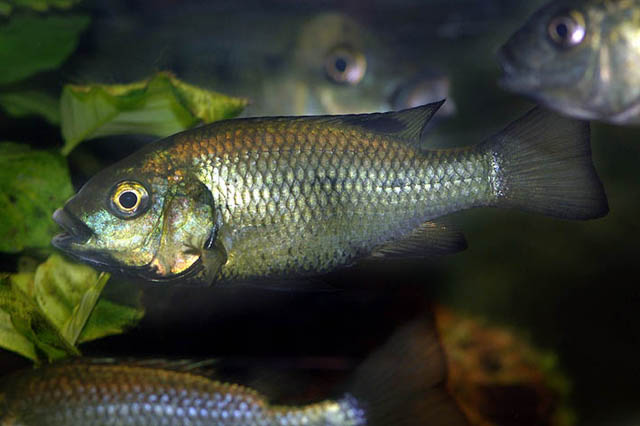| Cichlidae (Cichlids), subfamily: Pseudocrenilabrinae |
| 18.5 cm SL (male/unsexed) |
|
demersal; freshwater |
| Africa: endemic to Lake Barombi Mbo, West Cameroon (Ref. 4999, 52307, 81260). |
|
Dorsal spines (total): 14-16; Dorsal soft rays (total): 10-12; Anal spines: 3-3; Anal soft rays: 8-11; Vertebrae: 29. Diagnosis: 15-20 rakers on lower limb of first arch; 30-32 scales in lateral line (Ref. 81260). Body dark grey or green (Ref. 2, 81260). Head large, especially in adults (Ref. 2), its length 37-45% of standard length (Ref. 81260). Jaw teeth very small (Ref. 81260). Breeding males green; intense tilapia-mark present in young until about 10 cm SL, absent above 15 cm SL; as the gonads mature the lower parts of the head and the flanks become more metallic and green; most brooding females silver grey in general color; fins mainly of a neutral color; pelvic fins may be yellow (Ref. 2).
Description: body relatively slender; eyes large; adults with a pointed, specially-shaped snout ("saddle-nose"); juveniles deeper bodied with a more ovoid shape (Ref. 52307). Lower pharyngeal jaw with unicuspid anterior and posterior teeth; ventral keel elongate, longer than dentigerous plate; 3-6 rows of teeth in oral jaws, outer row teeth bicuspid in juveniles and females, unicuspid in adult males (Ref. 81260).
Coloration: base body color greenish, sometimes with black spots and blotches ventrally; fins generally with neutral color, but pelvics may be yellow; juveniles silvery, with very distinct "tilapia spot" in soft dorsal fin, but these are not present in adults (Ref. 81260). 2 short vertical bars may sometimes be visible in middle of body; rarely, pelvic fins in both sexes will appear reddish, as will some parts of belly and origin of anal fin (Ref. 52307). |
| Occasionally forms schools; is mainly diurnal; juveniles feed on mayfly larvae and various terrestrial insects among a diet in which animal items formed a high proportion (Ref. 2). Adults feed predominantly on phytoplankton (Ref. 2, 52307). Congregates in small groups (under 10 individuals) in open water regions and at a maximum depth of about 5 m (Ref. 52307). Lacks marked sexual dichromatism when sexually active (Ref. 81260). Ovophilic, maternal mouth brooder (Ref. 52307) that forms temporary pair bonds (Ref. 81260) prior to spawning, but none after (Ref. 52307). Ventures to regions near the edges of the lake for spawning, where the male constructs craters in the sand; males infrequently incubate the eggs (Ref. 52307). |
|
Critically Endangered (CR); Date assessed: 16 February 2009 (B1ab(iii)+2ab(iii)) Ref. (130435)
|
| harmless |
Source and more info: www.fishbase.org. For personal, classroom, and other internal use only. Not for publication.
